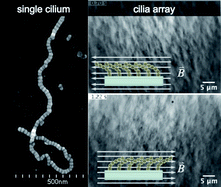Taking inspiration from eukaryotic cilia, we report a method for growing dense arrays of magnetically actuated microscopic filaments. Fabricated from the bottom-up assembly of polymer-coated cobalt nanoparticles, each segmented filament measures approximately 5–15 µm in length and 23.5 nm in diameter, which was commensurate with the width of a single nanoparticle. A custom microscope stage actuates the filaments through orthogonal permanent and alternating magnetic fields. We implemented design of experiments (DOE) to efficiently screen the effects of cobalt nanoparticle concentration, crosslinker concentration, and surface chemistry. The results indicated that the formation of dense, cilia-mimetic arrays could be explained by physical, non-covalent interactions (i.e. dipolar association forces) rather than chemistry. The experiments also determined an optimal Co nanoparticle concentration of approximately 500 µg ml−1 for forming dense arrays near the ends of the permanent magnets, and a critical concentration of approximately 0.3 µg ml−1, below which particle assembly into chains was not observed.

You have access to this article
 Please wait while we load your content...
Something went wrong. Try again?
Please wait while we load your content...
Something went wrong. Try again?


 Please wait while we load your content...
Please wait while we load your content...